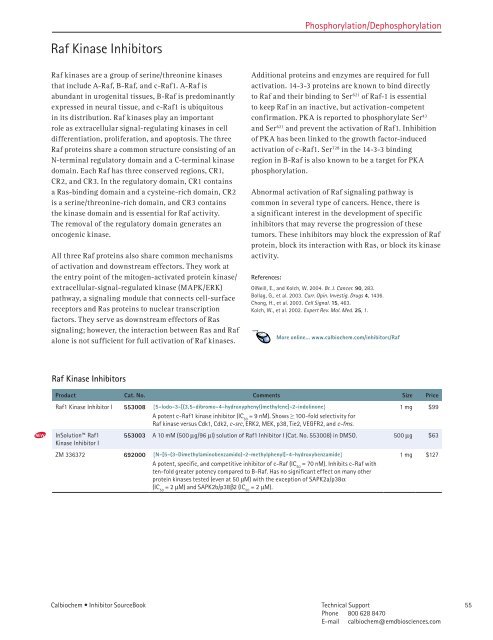Inhibitor SourceBook™ Second Edition
Inhibitor SourceBook™ Second Edition
Inhibitor SourceBook™ Second Edition
You also want an ePaper? Increase the reach of your titles
YUMPU automatically turns print PDFs into web optimized ePapers that Google loves.
Raf Kinase <strong>Inhibitor</strong>s<br />
Raf kinases are a group of serine/threonine kinases<br />
that include A-Raf, B-Raf, and c-Raf1. A-Raf is<br />
abundant in urogenital tissues, B-Raf is predominantly<br />
expressed in neural tissue, and c-Raf1 is ubiquitous<br />
in its distribution. Raf kinases play an important<br />
role as extracellular signal-regulating kinases in cell<br />
differentiation, proliferation, and apoptosis. The three<br />
Raf proteins share a common structure consisting of an<br />
N-terminal regulatory domain and a C-terminal kinase<br />
domain. Each Raf has three conserved regions, CR1,<br />
CR2, and CR3. In the regulatory domain, CR1 contains<br />
a Ras-binding domain and a cysteine-rich domain, CR2<br />
is a serine/threonine-rich domain, and CR3 contains<br />
the kinase domain and is essential for Raf activity.<br />
The removal of the regulatory domain generates an<br />
oncogenic kinase.<br />
All three Raf proteins also share common mechanisms<br />
of activation and downstream effectors. They work at<br />
the entry point of the mitogen-activated protein kinase/<br />
extracellular-signal-regulated kinase (MAPK/ERK)<br />
pathway, a signaling module that connects cell-surface<br />
receptors and Ras proteins to nuclear transcription<br />
factors. They serve as downstream effectors of Ras<br />
signaling; however, the interaction between Ras and Raf<br />
alone is not sufficient for full activation of Raf kinases.<br />
Raf Kinase <strong>Inhibitor</strong>s<br />
Calbiochem • <strong>Inhibitor</strong> SourceBook<br />
Phosphorylation/Dephosphorylation<br />
Additional proteins and enzymes are required for full<br />
activation. 14-3-3 proteins are known to bind directly<br />
to Raf and their binding to Ser 621 of Raf-1 is essential<br />
to keep Raf in an inactive, but activation-competent<br />
confirmation. PKA is reported to phosphorylate Ser 43<br />
and Ser 621 and prevent the activation of Raf1. Inhibition<br />
of PKA has been linked to the growth factor-induced<br />
activation of c-Raf1. Ser 728 in the 14-3-3 binding<br />
region in B-Raf is also known to be a target for PKA<br />
phosphorylation.<br />
Abnormal activation of Raf signaling pathway is<br />
common in several type of cancers. Hence, there is<br />
a significant interest in the development of specific<br />
inhibitors that may reverse the progression of these<br />
tumors. These inhibitors may block the expression of Raf<br />
protein, block its interaction with Ras, or block its kinase<br />
activity.<br />
References:<br />
OíNeill, E., and Kolch, W. 2004. Br. J. Cancer. 90, 283.<br />
Bollag, G., et al. 2003. Curr. Opin. Investig. Drugs 4, 436.<br />
Chong, H., et al. 2003. Cell Signal. 15, 463.<br />
Kolch, W., et al. 2002. Expert Rev. Mol. Med. 25, .<br />
Product Cat. No. Comments Size Price<br />
Raf Kinase <strong>Inhibitor</strong> I 553008 {5-Iodo-3-[(3,5-dibromo-4-hydroxyphenyl)methylene]-2-indolinone}<br />
A potent c-Raf kinase inhibitor (IC 50 = 9 nM). Shows ≥ 00-fold selectivity for<br />
Raf kinase versus Cdk , Cdk2, c-src, ERK2, MEK, p38, Tie2, VEGFR2, and c-fms.<br />
N InSolution Raf<br />
Kinase <strong>Inhibitor</strong> I<br />
More online... www.calbiochem.com/inhibitors/Raf<br />
mg $99<br />
553003 A 0 mM (500 mg/96 ml) solution of Raf <strong>Inhibitor</strong> I (Cat. No. 553008) in DMSO. 500 mg $63<br />
ZM 336372 692000 {N-[5-(3-Dimethylaminobenzamido)-2-methylphenyl]-4-hydroxybenzamide}<br />
A potent, specific, and competitive inhibitor of c-Raf (IC 50 = 70 nM). Inhibits c-Raf with<br />
ten-fold greater potency compared to B-Raf. Has no significant effect on many other<br />
protein kinases tested (even at 50 mM) with the exception of SAPK2a/p38a<br />
(IC 50 = 2 mM) and SAPK2b/p38b2 (IC 50 = 2 mM).<br />
mg $ 27<br />
Technical Support<br />
Phone 800 628 8470<br />
E-mail calbiochem@emdbiosciences.com<br />
55



